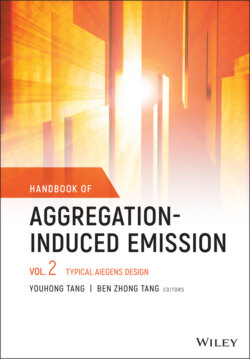Читать книгу Handbook of Aggregation-Induced Emission, Volume 2 - Группа авторов - Страница 16
1.2.2 Suzuki–Miyaura Reaction
ОглавлениеNormally, tetraphenylpyrazines are prepared by cyclization reaction with benzoin and benzil, etc, as starting materials, and nearly all the structures can be designed based on the above routes. However, Langer reported a new route to synthesize tetrasubstituted tetraphenylpyrazines by the classical Suzuki–Miyaura reaction (Scheme 1.1, Route 5) [49]. In this case, the molecules are prepared by the carbon–carbon coupling of tetrachloropyrazine and arylboronic acid with palladium complexes, phosphorus compounds, and potassium phosphate as catalyst, ligand, and base, respectively. It is probably due to the withdrawing property of central pyrazine that increases the reactivity of peripheral chlorine. Compared with Pd(PPh3)4, Pd(OAc)2 shows a higher catalytic activity. By applying Pd(OAc)2 as catalyst, choosing different ligands like S‐phos, CataCXium, and tricyclohexylphosphine exhibits similar reaction efficiency. The university of arylboronic acids is extremely wide, while the electronic effect of substituents and the steric effect exert less influence on the reaction reactivity.
The tetrachloropyrazine is prepared by heating a mixture of glycine anhydride, PCl5, and POCl3 at 120 °C. Most of the starting materials are toxic, and the purification process after the reaction is difficult. Although the tetrachloropyrazine is commercially available, the cost is relatively high. It is thus considerable to choose this method for preparation. However, it possesses some difference when compared with the above reactions. For example, it is almost impossible to synthesize tetraldehyde‐substituted TPP with the cyclization reaction. By contrast, reacting tetrachloropyrazine with 4‐formylphenylboronic acid by the Suzuki–Miyaura reaction may afford the product readily.
